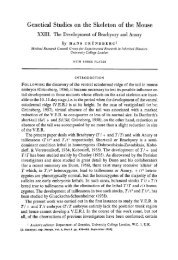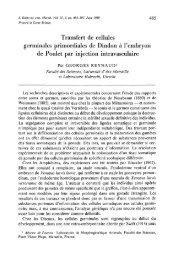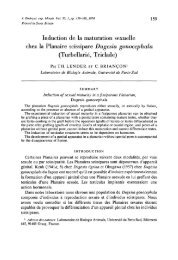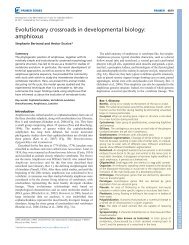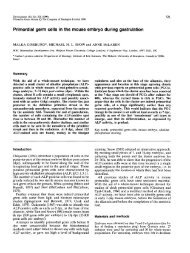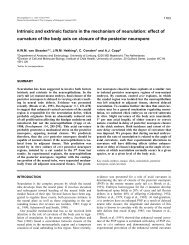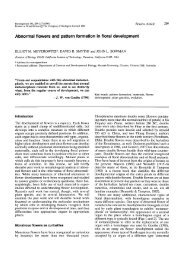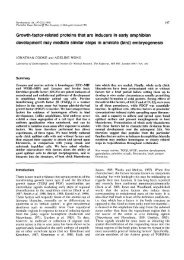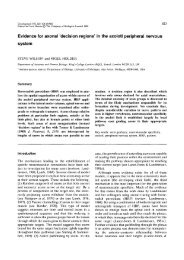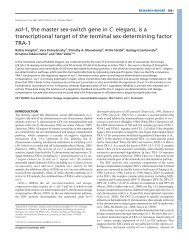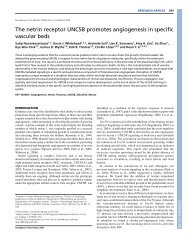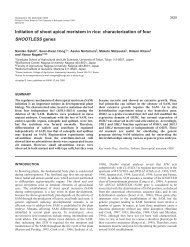Effects of insulin insufficiency on forelimb and tail ... - Development
Effects of insulin insufficiency on forelimb and tail ... - Development
Effects of insulin insufficiency on forelimb and tail ... - Development
You also want an ePaper? Increase the reach of your titles
YUMPU automatically turns print PDFs into web optimized ePapers that Google loves.
444 SWANI VETHAMANY-GLOBUS AND R. A. LIVERSAGE<br />
obtained better results, in terms <str<strong>on</strong>g>of</str<strong>on</strong>g> animal survival, the rate <str<strong>on</strong>g>of</str<strong>on</strong>g> regenerati<strong>on</strong> <strong>and</strong><br />
the degree <str<strong>on</strong>g>of</str<strong>on</strong>g> morphogenesis, when he injected ACTH rather than cortis<strong>on</strong>e<br />
acetate into hypophysectomized animals. Thus, it is possible that ACTH promotes<br />
limb regenerati<strong>on</strong> in hypophysectomized animals by directly stimulating<br />
the producti<strong>on</strong> <str<strong>on</strong>g>of</str<strong>on</strong>g> <str<strong>on</strong>g>insulin</str<strong>on</strong>g> in additi<strong>on</strong> to its effect <strong>on</strong> the adrenals.<br />
In additi<strong>on</strong> to the corticosteroids, other horm<strong>on</strong>es which have been shown to<br />
support limb regenerati<strong>on</strong> are also known to stimulate <str<strong>on</strong>g>insulin</str<strong>on</strong>g> producti<strong>on</strong>. For<br />
example, growth horm<strong>on</strong>e injected into hypophysectomized adult newts promotes<br />
normal limb regenerati<strong>on</strong> (Wilkers<strong>on</strong>, 1963). There are also data available<br />
which show that limb regenerati<strong>on</strong> is dependent up<strong>on</strong> the presence <str<strong>on</strong>g>of</str<strong>on</strong>g> an intact<br />
thyroid gl<strong>and</strong> (Schmidt, 1968; Schotte & Washburn, 1954). C<strong>on</strong>nelly et ah<br />
(1968) have shown that prolactin, in combinati<strong>on</strong> with thyroxine, promotes<br />
limb regenerati<strong>on</strong> in hypophysectomized animals.<br />
There is an interesting correlati<strong>on</strong> between the horm<strong>on</strong>es menti<strong>on</strong>ed above<br />
<strong>and</strong> the producti<strong>on</strong> <str<strong>on</strong>g>of</str<strong>on</strong>g> <str<strong>on</strong>g>insulin</str<strong>on</strong>g>. Growth horm<strong>on</strong>e, prolactin, thyroxine, corticosteroids<br />
<strong>and</strong> ACTH are known to stimulate the producti<strong>on</strong> <str<strong>on</strong>g>of</str<strong>on</strong>g> <str<strong>on</strong>g>insulin</str<strong>on</strong>g> (Bern &<br />
Nicoll, 1968; Haist, 1959; Lazarus et al 1962; Tepperman, 1965). It has also<br />
been shown that hypophysectomy in additi<strong>on</strong> to inhibiting limb <strong>and</strong> <strong>tail</strong> regenerati<strong>on</strong><br />
in adult newts, results in the atrophy <str<strong>on</strong>g>of</str<strong>on</strong>g> the pancreas (Vethamany,<br />
1970). Thus the possibility exists that all <str<strong>on</strong>g>of</str<strong>on</strong>g> these horm<strong>on</strong>es promote limb <strong>and</strong><br />
<strong>tail</strong> regenerati<strong>on</strong> either directly <strong>and</strong>/or indirectly by stimulating the producti<strong>on</strong><br />
<str<strong>on</strong>g>of</str<strong>on</strong>g> <str<strong>on</strong>g>insulin</str<strong>on</strong>g> (see Fig. 17). Since hypophysectomy or pancreatectomy brings about<br />
widespread derangements in the metabolism, it is highly unlikely that <strong>on</strong>ly <strong>on</strong>e<br />
specific horm<strong>on</strong>e is involved in regenerati<strong>on</strong>. It is more likely that these horm<strong>on</strong>es<br />
do not act in isolated pathways but interact interdependently through<br />
their effects <strong>on</strong> the metabolism.<br />
When the source <str<strong>on</strong>g>of</str<strong>on</strong>g> <str<strong>on</strong>g>insulin</str<strong>on</strong>g> is removed from an animal, a marked sequence <str<strong>on</strong>g>of</str<strong>on</strong>g><br />
events occurs which is intricately interc<strong>on</strong>nected. These events involve not <strong>on</strong>ly<br />
carbohydrate metabolism, but also fat, protein <strong>and</strong> nucleic acid metabolism as<br />
well as electrolyte <strong>and</strong> water balance (see review by Tepperman, 1965). Regenerati<strong>on</strong><br />
processes in adult newts also involve carbohydrate, lipid, protein <strong>and</strong><br />
nucleic acid syntheses (see review by Schmidt, 1968). In resp<strong>on</strong>se to severe<br />
injury in mammals, large quantities <str<strong>on</strong>g>of</str<strong>on</strong>g> corticosteroids have been found in the<br />
circulati<strong>on</strong> during the first 24 to 48 h <strong>and</strong>, as a result, hyperglycemia ensues<br />
(Schmidt, 1968). If this is true in urodeles, hyperglycemia is likely to stimulate<br />
<str<strong>on</strong>g>insulin</str<strong>on</strong>g> producti<strong>on</strong>. Schmidt (1968) has reported that glycogen <strong>and</strong> lipids are<br />
synthesized in the blastema cells prior to differentiati<strong>on</strong>; these are probably<br />
utilized, later, as a substrate reservoir for metabolic events essential to the cells<br />
in regenerati<strong>on</strong>. Insulin might play a role in this initial synthesis <str<strong>on</strong>g>of</str<strong>on</strong>g> glycogen<br />
<strong>and</strong> lipids.<br />
Chalkley (1959) has shown that mitotic activity during regenerati<strong>on</strong> reaches<br />
its maximum level around 25-31 days after amputati<strong>on</strong>. Also studies c<strong>on</strong>cerning<br />
the inhibiti<strong>on</strong> <str<strong>on</strong>g>of</str<strong>on</strong>g> mitotic activity, using X-irradiati<strong>on</strong> (Butler, 1933) <strong>and</strong> colchi-



